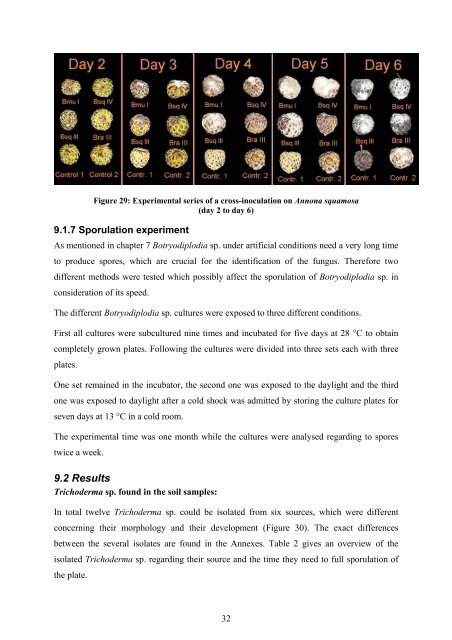Botryodiplodia sp. - Crops for the Future
Botryodiplodia sp. - Crops for the Future
Botryodiplodia sp. - Crops for the Future
Create successful ePaper yourself
Turn your PDF publications into a flip-book with our unique Google optimized e-Paper software.
Figure 29: Experimental series of a cross-inoculation on Annona squamosa<br />
(day 2 to day 6)<br />
9.1.7 Sporulation experiment<br />
As mentioned in chapter 7 <strong>Botryodiplodia</strong> <strong>sp</strong>. under artificial conditions need a very long time<br />
to produce <strong>sp</strong>ores, which are crucial <strong>for</strong> <strong>the</strong> identification of <strong>the</strong> fungus. There<strong>for</strong>e two<br />
different methods were tested which possibly affect <strong>the</strong> <strong>sp</strong>orulation of <strong>Botryodiplodia</strong> <strong>sp</strong>. in<br />
consideration of its <strong>sp</strong>eed.<br />
The different <strong>Botryodiplodia</strong> <strong>sp</strong>. cultures were exposed to three different conditions.<br />
First all cultures were subcultured nine times and incubated <strong>for</strong> five days at 28 °C to obtain<br />
completely grown plates. Following <strong>the</strong> cultures were divided into three sets each with three<br />
plates.<br />
One set remained in <strong>the</strong> incubator, <strong>the</strong> second one was exposed to <strong>the</strong> daylight and <strong>the</strong> third<br />
one was exposed to daylight after a cold shock was admitted by storing <strong>the</strong> culture plates <strong>for</strong><br />
seven days at 13 °C in a cold room.<br />
The experimental time was one month while <strong>the</strong> cultures were analysed regarding to <strong>sp</strong>ores<br />
twice a week.<br />
9.2 Results<br />
Trichoderma <strong>sp</strong>. found in <strong>the</strong> soil samples:<br />
In total twelve Trichoderma <strong>sp</strong>. could be isolated from six sources, which were different<br />
concerning <strong>the</strong>ir morphology and <strong>the</strong>ir development (Figure 30). The exact differences<br />
between <strong>the</strong> several isolates are found in <strong>the</strong> Annexes. Table 2 gives an overview of <strong>the</strong><br />
isolated Trichoderma <strong>sp</strong>. regarding <strong>the</strong>ir source and <strong>the</strong> time <strong>the</strong>y need to full <strong>sp</strong>orulation of<br />
<strong>the</strong> plate.<br />
32

















